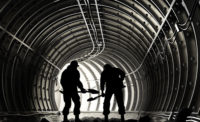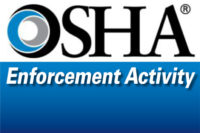OSHA defines a “Permit-Required Confined Space” as any space that meets the definition of confined space (a space in which the configuration hinders the employee’s activities who must enter, work in and exit the space) and poses a health or safety risk. These risks can range from oxygen deficiency to close proximity to moving parts, all of which have the risk of causing bodily harm or, even worse, death.
When entering a confined space, one of the most dangerous factors is that the hazards faced can be quite deceiving.
Elements that define a confined space e.g., restricted air flow, confinement, etc., can quickly escalate the dangers that would not be present otherwise in an open environment. For example, in an open space, the release of vapors from a toxic substance would dissipate into the air; however, in a confined space, these vapors can quickly concentrate, raising the levels to Immediately Dangerous to Life or Health (IDLH).
The employer is obligated to evaluate the workplace to determine if any spaces are “Permit-Required Confined Spaces” and if an area is determined to fall within this category, a permit space program must be developed. This entails the development of an overall plan designed to protect employees from the hazards and for regulating employee entry into said “Permit-Required Confined Space.”
Details for an acceptable permit space program can be found in OSHA Standard 29 CFR 1910.146 (the standard). This standard further explains that should the environment be deemed as a “Permit-Required Confined Space,” then the employer must design and implement a permit space program that incorporates measures to reduce or eliminate the risks associated with the space, outlines the implementation of required permits for entry, provides thorough training for all employees whose work is associated with the space, and provides for proper strategy and execution for emergency services.
Put programs in place
If employees are required to enter this environment, the following programs must be put into effect. First, a full permit-required space program requires that measures necessary to prevent any unauthorized personnel from entering the space, be taken. And second, the hazards must be evaluated in order to develop a program for safe entry into the permit space and must specify acceptable entry conditions.
The standard requires that once a permit space is found in the workplace, the employer must immediately inform exposed employees of the existence and location of the danger posed by posting danger signs or by any other equally effective means. It is equally important to note that external hazards must be identified by providing and installing pedestrian, vehicle or other barriers.
Prior to entry, the hazards must be tested to determine if they meet acceptable entry conditions and the area where authorized entrants are working must be continuously monitored. When testing or monitoring the space, first test for oxygen, then for combustible gasses and vapors, and finally for toxic gasses and vapors. First and foremost, eliminating or controlling the atmospheric hazard is essential; isolating the permit space and purging, inerting, flushing or ventilating the space as necessary is required. Prior to entry, hazards that have been reduced or eliminated to meet acceptable entry conditions, and whether those conditions will remain constant throughout the duration of an authorized entry, must be verified.
Employers must also provide an opportunity for all authorized entrants to observe any monitoring or testing of all permit spaces. Any entrant, or that employee’s authorized representative, must not only have the opportunity to observe the testing and monitoring data, but they have the right to ask for a reevaluation should they deem it necessary.
Should engineering and work practice controls fall short in adequately protecting employees, personal protective equipment (PPE) and any additional equipment that may be required for safe entry into and rescue from said space must be administered at no cost to the employee. All employees must be trained on the use and care of this equipment and it must be properly maintained at all times.
Entry permits
A system for preparation, issuance, use and cancellation of entry permits must be developed and implemented. Should employees of multiple employers be working simultaneously as authorized entrants in the permit space, procedures must be implemented where employees from one employer will not endanger the employees from another.
Upon the completion and documentation of all precautions mentioned above, a permit may be constructed. The permit shall identify:
- Permit space to be entered, the purpose of entry and the date;
- Authorized entrants within the permit space;
- Amount of time each authorized entrant will be present in the space;
- Name of those serving as attendants;
- Current supervisor;
- Hazards present;
- Measures used to isolate the space and eliminate or control permit space hazards before entry;
- Acceptable entry conditions;
- Results of the initial and periodic tests performed, accompanied by the names and initials of the testers;
- Dates when tests were completed;
- Rescue and emergency services that can be summoned and how;
- Communication procedures for maintaining contact during entry;
- List of all equipment to be used; and
- Any other information required to ensure the employee safety.
Before entry begins, this permit must be signed by the identified supervisor and, at the time of entry, it must be posted at the entry of the permit space and made available to all authorized entrants. At any time, should conditions not meet the requirements for entry, the supervisor should terminate entry and cancel the permit.
Train workers
Training of employees is vital and arguably one of the most important elements of this program. Training should ensure that all employees whose work involves permit-required spaces acquire the understanding, knowledge and skills necessary for the safe performance of all duties assigned. These include, but are not limited to, those who will be entering the space, those who will be servings as attendants and supervisors. Training should cover all aspects of the job, including: understanding possible hazards; how to recognize warning signs or symptoms of exposure; how best to react to those warning signs; detection of prohibited conditions; evacuation procedures; communication procedures; and any equipment required to complete the job.
Should there be a change in assignment, environment or any other condition that could affect the safety and health of an employee, additional or updated training must be provided. All training must be certified by the employer and available for inspection by employees or their authorized representatives.
At least one attendant must be stationed outside of the permit space for the entire duration of work being performed in the space; however, that attendant may monitor more than one permit space as long as their duties can be effectively performed for each space. If one attendant is charged with monitoring more than one space, effective procedures must be in place to enable the attendant to respond to an emergency affecting one or more of the permit spaces without interrupting the responsibilities of his post.
Arrange for rescue
Sixty percent of confined space fatalities occur among would-be rescuers.1 A rescuer’s ability to recognize and properly respond to an emergency could mean the difference between a job well done and catastrophe. Should rescue or emergency services be required, it is important to evaluate the responder’s capabilities to reach victims within an appropriate time frame, and ensure that they are equipped to effectively perform the necessary services.
It is imperative that rescue teams are provided with access to all permit spaces and that they are informed of whatever hazards they may confront. Should an employer designate employees to provide rescue, then proper PPE and training must be provided. To ensure the team is adequately prepared, rescue trainings and simulations must be performed annually, keeping the team versed in the latest rescue techniques and procedures.
Companies should continuously monitor and evaluate the permit space program and review it annually, at a minimum. Any deficiencies found should be corrected before subsequent entries are authorized.
Footnote
1 “Confined Spaces Can Be Deadly,” Confined Space Hazard Alert, Research & Educational Unit, Cal/OSHA Consultation Service, January 2012.



